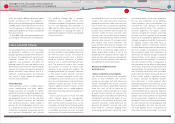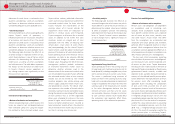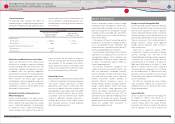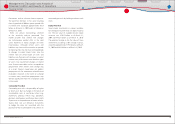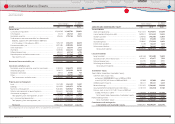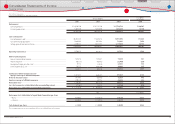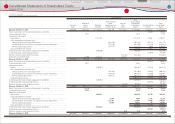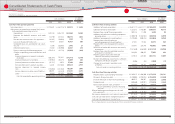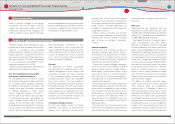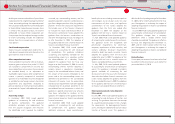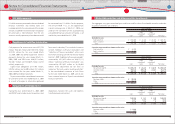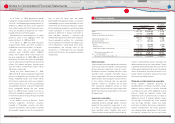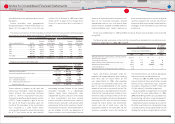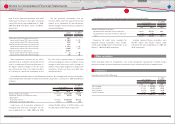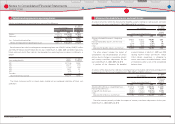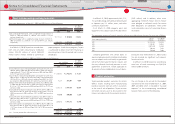Toyota 2010 Annual Report Download - page 69
Download and view the complete annual report
Please find page 69 of the 2010 Toyota annual report below. You can navigate through the pages in the report by either clicking on the pages listed below, or by using the keyword search tool below to find specific information within the annual report.
67
TOYOTA ANNUAL REPORT 2010
managements best estimate of expenses related
to future recalls and other safety measures. The
estimation model for recalls and other safety
measures takes into account Toyotas historical
experience and individual occurrences of recalls
and other safety measures. This change resulted
from Toyotas most recent experience with
recalls and other safety measures changes in the
operating processes such as the establishment
of the Special Committee for Global Quality to
address quality-related matters, as well as the
broadening of the number of vehicles subject to
recalls and other safety measures. This change
has resulted in a decrease in each of operating
income and income before income taxes and
equity in earnings of affi liated companies by
¥105,698 million ($1,136 million) in the fourth
quarter of this consolidated fi scal year.
Research and development costs are expensed
as incurred. Research and development costs
were ¥958,882 million, ¥904,075 million and
¥725,345 million ($7,796 million) for the
years ended March 31, 2008, 2009 and 2010,
respectively.
Cash and cash equivalents
Cash and cash equivalents include all highly liquid
investments with original maturities of three
months or less, that are readily convertible to
known amounts of cash and are so near maturity
that they present insignifi cant risk of changes in
value because of changes in interest rates.
Marketable securities
Marketable securities consist of debt and
equity securities. Debt and equity securities
designated as available-for-sale are carried
at fair value with unrealized gains or losses
included as a component of accumulated other
comprehensive income in shareholders equity,
net of applicable taxes. Individual securities
classifi ed as available-for-sale are reduced to
net realizable value for other-than-temporary
declines in market value. In determining if
a decline in value is other-than-temporary,
Toyota considers the length of time and the
extent to which the fair value has been less
than the carrying value, the fi nancial condition
and prospects of the company and Toyotas
ability and intent to retain its investment in the
company for a period of time suffi cient to allow
for any anticipated recovery in market value.
Realized gains and losses, which are determined
on the average-cost method, are refl ected in the
statement of income when realized.
Security investments in non-public companies
Security investments in non-public companies
are carried at cost as fair value is not readily
determinable. If the value of a non-public
security investment is estimated to have declined
and such decline is judged to be other-than-
temporary, Toyota recognizes the impairment of
the investment and the carrying value is reduced
to its fair value. Determination of impairment is
based on the consideration of such factors as
operating results, business plans and estimated
future cash fl ows. Fair value is determined
principally through the use of the latest fi nancial
information.
Finance receivables
Finance receivables are recorded at the present
value of the related future cash fl ows including
residual values for fi nance leases. Incremental
direct costs incurred in connection with the
acquisition of fi nance receivables are capitalized
and amortized so as to approximate a level rate
of return over the term of the related contracts.
Wholesale and other dealer loan receivables are
placed on nonaccrual status when full payment
of principal or interest is in doubt or principal or
interest is 90 days or more contractually past due,
whichever occurs fi rst. Retail and fi nance lease
receivables are not placed on nonaccrual status.
Rather, these receivables are charged off when
payments due are no longer expected to be
received or the account is 120 days contractually
delinquent, whichever occurs fi rst.
Interest income on nonaccrual receivables is
recognized only to the extent it is received in
cash. Accounts are restored to accrual status
only when principal and interest payments
are brought current and future payments are
reasonably assured.
Finance receivables on nonaccrual status
were ¥34,586 million and ¥26,599 million ($286
million) and fi nance receivables past due over
90 days and still accruing were ¥43,370 million
and ¥38,150 million ($410 million) as of March 31,
2009 and 2010, respectively.
Allowance for credit losses
Allowance for credit losses is established to
cover probable losses on receivables resulting
from the inability of customers to make required
payments. Provision for credit losses is included
in selling, general and administrative expenses.
The allowance for credit losses is based on a
systematic, ongoing review and evaluation
performed as part of the credit-risk evaluation
process, historical loss experience, the size and
composition of the portfolios, current economic
events and conditions, the estimated fair value
and adequacy of collateral and other pertinent
factors.
In the allowance for credit losses, general
reserves are collectively calculated by applying
reserve rates to each homogenous portfolio. This
reserve rate is based on historical loss experience,
current economic events and conditions and
other pertinent factors. Specifi c reserves on
identifi ed receivables are determined by the
present value of expected future cash fl ows or
the fair value of collateral when it is probable
that such receivables will be unable to be fully
collected.
Losses are charged to the allowance when
it has been determined that payments will not
be received and collateral cannot be recovered
or the related collateral is repossessed and sold.
Any shortfall between proceeds received and the
carrying cost of repossessed collateral is charged
to the allowance. Recoveries are reversed from
the allowance for credit losses.
Allowance for residual value losses
Toyota is exposed to risk of loss on the
disposition of off -lease vehicles to the extent
that sales proceeds are not suffi cient to cover
the carrying value of the leased asset at lease
termination. Toyota maintains an allowance
to cover probable estimated losses related to
unguaranteed residual values on its owned
portfolio. The allowance is evaluated considering
projected vehicle return rates and projected loss
severity. Factors considered in the determination
of projected return rates and loss severity include
historical and market information on used
vehicle sales, trends in lease returns and new
car markets, and general economic conditions.
Management evaluates the foregoing factors,
develops several potential loss scenarios, and
reviews allowance levels to determine whether
reserves are considered adequate to cover the
probable range of losses.
Financial Section
Financial Section
Investor Information
Corporate Information
Special Feature
Consolidated
Performance Highlights
Business Overview
Top Messages
Notes to Consolidated Financial Statements


